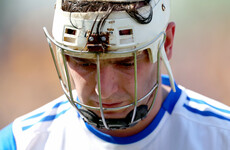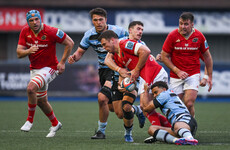WE’VE SEEN SOME teams producing very high penalty counts as rugby has resumed around the world in recent months and weeks, with Super Rugby Aotearoa in New Zealand providing a prime example.
The Kiwi competition involved exceptionally high penalty counts in the early rounds but they gradually settled down as players got more accustomed to a renewed focus from referees on strictly policing the existing laws around the breakdown.
This came after World Rugby underlined the need to clean up the breakdown in order to make it safer and faster. Another hoped-for effect of tidying it up is more clean turnovers in the game, resulting in exciting passages of turnover attack.
Some teams in England struggled with the renewed focus last weekend too, so it’s worth reminding ourselves of what World Rugby highlighted around the breakdown as Irish rugby gets set to resume this evening.
There are no new laws involved here, simply a stronger focus on penalising illegal play around the breakdown. There may be teething issues, as there have been elsewhere, but the long-term gain of a cleaner, safer breakdown should be worth it.
Statistically speaking, the 10 rounds of Super Rugby Aotearoa produced quicker ruck ball than had been the case in the actual Super Rugby competition earlier in 2020.
An average improvement of 0.44 seconds per attacking ruck in the opposition’s half might not sound like a huge amount but that all adds up over the course of a game, and a lighting-quick recycle at the breakdown can leave defences less organised.
The average penalty count went up from 19 to 22 per game in Super Rugby Aotearoa, and specifically in the breakdown/ruck area it went up from nine to 12 on average.
Players holding on – jackal turnover penalties – were the most common breakdown penalties at 33% per game, but players going off their feet [20%], tacklers failing to roll away [18%], and illegal entry angles [14%] were all common too.
Whereas in Super Rugby earlier this year, we had seen the defensive team penalised more frequently at the breakdown on average, that changed in Super Rugby Aotearoa as the attacking team was penalised more often at the breakdown.
Interestingly, Super Rugby Aotearoa delivered fewer tries on average than Super Rugby [down from seven to six] but more successful penalty kicks at goal [up from two to four], which would certainly appear to have been at least partly as a result of the renewed focus from referees around the breakdown.
It will be interesting to note if or how the renewed focus affects the restart of rugby in Ireland over the coming days but here’s what referees have been asked to focus on and the things we should be watching out for.
Tackler rolling away
This has always been vital but we have seen referees being even more stringent in this regard.
There is essentially no tolerance now for the tackler not rolling clear to the side of the tackle in order to allow the team in possession to recycle.
Referees are hot on penalising any tacklers who roll into the path of the arriving attacking players or scrum-half, so they must roll away to the side. The terminology match officials are using here is that they want the tackler rolling ‘east or west’.
We have seen many strong jackal turnover attempts denied because a tackler hasn’t rolled away first.
The ball carrier on the ground
The next focus for referees has been on the ball carrier and ensuring they’re not adding in extra rolls, crawls or movements on the ground after being tackled.
The ball carrier is allowed ‘one dynamic movement’ to place the ball, so the days of tackled players thrashing around on the ground like salmon pulled out of the water are finished.
This promises to be a challenging area for Irish players, with Joe Schmidt’s demand for what he called ‘bodyball’ – that fight on the ground – relentless during his time in Ireland and extremely influential through all levels of rugby.
Old habits will have to be shed.
The jackaler
The next thing of keen interest for the referee is any defensive player arriving in an attempt to win a turnover.
This has been a fascinating part of rugby in New Zealand and elsewhere, with jackalers who are in good positions winning penalties quicker than before as long as they fulfil clear criteria.
Firstly, their angle of entry must be legal – so coming from the direction of their own goal-line behind them, rather from the side. The jackaling player must be clearly on their feet, so not flopping over the ball, placing their hands beyond it to support themselves.
They must actually be on the ball too - so clearly with their hands at the ball, rather than around the ball carrier’s body. And perhaps most importantly, they need to show they are actively attempting to lift the ball away from the ball carrier – not simply resting in place.
Once these factors are satisfied, we have seen referees blowing their whistles earlier and very often commenting that the jackal was “clearly lifting the ball.”
Thankfully, the terminology of ‘surviving’ the clearout seems to have been eradicated from the game, which is welcome from a player welfare standpoint.
So jackaling players now have a very clear checklist to tick off as they look to make steals. If they fail to hit those markers, they will be penalised far quicker too – again, a positive as we look to speed up the game.
On a side note, we have seen many examples of teams in New Zealand counter-rucking for turnovers in recent times – it will be interesting to see if the trend continues in this part of the world.
Other arriving players
The match officials’ next focus is on attacking players arriving to the breakdown.
In a hugely welcome move, we are seeing side entry penalised more often. It’s one of the most dangerous things about rugby, with jackaling players’ lower limbs too often suffering from illegal side entries in the past.
Arriving players have to come from the direction of their own goal line, having squared up to the opposition’s goal line. As long as they arrive in ‘square’ in this fashion, arriving player can then angle slightly inwards during their clearout, but that first arrival angle is key.
Another big focus is for arriving players to ‘drive not dive,’ meaning they can’t just fly in off their feet to smash a defender away. On top of that, any ‘sealing off’ where arriving players flop over the ball to prevent a contest is being strictly penalised – this has been highly evident in New Zealand.
[One thing to watch here is the 'matador,' where a defender makes a dummy jackal movement then steps away in a bid to lure the arriving attacking player into going off their feet. If the arriving player was in a good position to make a genuine clearout, driving not diving, this generally isn't a penalty].
Referees have also been asked to severely penalise arriving players who make an initial contact point with the knees of a jackaler too – again in a bid to prevent horror injuries – so that point of contact must be on the shoulders, torso, or hips and upper thigh area.
As before, there is a focus on arriving players not clearing out too deep beyond the ruck.
So there are many demands on the arriving players, all in a bid to ensure they are not out of control as they come into the breakdown.
Foul play
It’s obvious but worth mentioning – referees have been asked to severely punish any foul play around the breakdown.
Lifting legs above the horizontal, any stamping, and neck rolls are in this category.
Another important one is shoulder charges from arriving players, where they tuck their arms into the ‘sling’ position and make no attempt to actually bind onto the player they’re looking to clearout. Referees have been asked to clamp it out of the game.
Offside
One other quick point to touch on here is the renewed focus on the offside line. Referees and their assistants have been asked to ensure they’re more accurate in this area.
We saw in the early rounds of Super Rugby Aotearoa how that could contribute to games being stop-start at times but penalties are the only way to force players to change and take an extra step back. Overall, there were more offside penalties in Super Rugby Aotearoa than there were scrum penalties.
Again, look out for a few of these over the weekend.














Even the Aussie media are disappointed a true legend of the sport wont feature this saturday
https://www.youtube.com/watch?feature=player_embedded&v=FeaDsc5GfO8